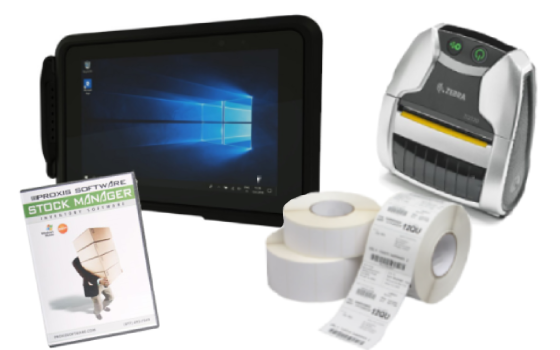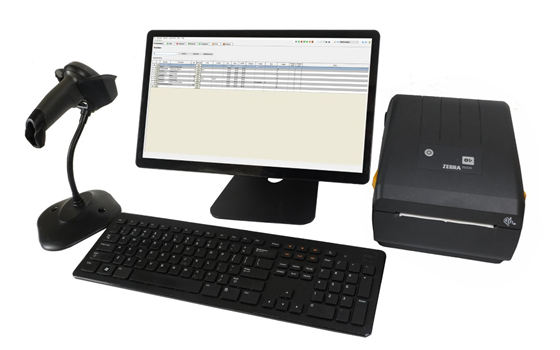Making a Barcode-Based Inventory System Work for Your Business
Is your current method for tracking inventory not making the cut?
Are inaccuracies in your counts slowing down business and causing confusion? A modern barcode-based inventory system might be the solution. Building an effective system isn’t hard (or expensive) if you follow a few basic steps. Let’s break them down!
Step 1: Define Locations in your Store or Warehouse.
Any place that your stock might live should have a defined name that you can easily remember and locate - no matter whether it’s an aisle on your sales floor or a shelf tucked away in the back of your office.
Pro-Tip: Have a clear system for determining your location names that anyone can understand. Labeling a location “Right Shelf” might not work if there are four potential right shelves for an employee to choose from.
Step 2: Assign Descriptions & Part Numbers to your Stock.
Some business owners want to track every item in their business - others only want to track the things they use on a day-to-day basis. The approach you take is up to you but wherever you go, ensure that every item you’re tracking has a unique description and a part number (also known as a Stock Keeping Unit or SKU for short).
Descriptions should be concise enough for quick readability on a report but detailed enough that anyone in your organization - from the warehouse stocker to the accountant - can get an idea of what is being described.
Next are the part numbers. If you’re a retailer selling products from other vendors or manufactures, your products might already have UPC barcodes that you can use to simplify the process. If need to make them yourself, there are two general ways you can approach their creation. Both options have their pros and cons.
Option 1 is a descriptive part number with information embedded into the code. For example, a hat company making a size 7 ½ blue suede fedora might use “FED-SD-02-75” where “02” refers to a color and “75” refers to size. This type of part number makes it easy to identify information about the product and it’s location and but it also requires extra training to decipher parts of the code and requires extra work to maintain consistency across product lines.
Option 2 is a serialized part number where numbers are generated in numerical order regardless of the item. For example, your hat from above might now just be “3156” These codes are easy to generate for new products and require less training for new hires but can make it harder to identify items at a glance. Avoid starting numbers with 0 as some software like Excel will automatically drop it from the start.
Pro Tip: Think outside of finished products. Inventorying raw materials and general business supplies is a great way to improve business efficiency and reduce downtime. Have tools and expensive machinery that move around your business? Consider pairing your inventory tracking with an asset tracking system as well.
Step 3: Label your Inventory & Locations with Barcodes
When making barcode labels you have two things to consider: The layout of the label and how you’ll print it.
Layout is pretty simple. Include the written out part number (or location) on the label in text large enough to be seen from a distance. Then, slap on a barcode. The barcode you put on the label will vary depending on your industry and where it will be used. Our Guide to Choosing Barcodes goes into depth on which one you should use. We offer free and paid label printing software to meet a range of needs.
For making the label, you’ll want to consider what sort of conditions the label might face during storage. Will it be exposed to moisture or sunlight? Will it be rubbing against other items? All these will determine what material your label should be made with. Our guide to picking the right label printer for your business covers the answers to some of these questions.
Step 4: Pick a Software to do the Tracking for You & Upload your Data
One of the biggest choices you’ll have to make is what inventory tracking software to use.
If you’re a retail or restaurant location, your POS software might already have a built-in system you can use. If you’re a manufacturer, you might have warehouse management software that does the trick. These are great because they’ll automatically add and subtract inventory as you take orders or receive product.
If you don’t already have software with built-in functionality, there are a few things to consider when picking software:
- Will it integrate with other software you might be using?
- Is your inventory stored locally or hosted in the cloud? If on the cloud, how is that data being backed up?
- How customizable is the software? Can entry fields be changed to meet your unique needs?
- Is it Windows, Android, or iOS based? Mobile applications are great for inventory management because you can pair them with mobile computers that have integrated scanners - improving efficiency overall.
- If you’re a manufacturer, consider software with forecasting tools that look at historical inventory data and make suggestions on when to buy new product. Some can even place orders automatically to ensure you always have what you need.
POSGuys sells a range of software to meet different requirements. Give us a call and we can help pair you with software that’s right for your business.
Step 5: Get Employee Buy-In
Any tracking system is only as good as the people using it. If they’re not entering data correctly and following procedures, you’re inventory is bound to be off. Ask for your employees’ input throughout the process and involve them when appropriate. We might’ve included that last but this is something you should be doing at every step of the process.
You’d be surprised what feedback you might not have considered. This trick will separate a decent inventory system from a great one.
Not sure where to start? Let us do the work for you.
Our team of sales engineers can help you build a custom solution that meets your needs and budget. All our equipment comes with free lifetime technical support based here in the USA, so you can be confident knowing you’ll always have someone on your side.
Want to Make it Easy? Try a Pre-Built Kit!
Mobile Inventory Tracking Kit

Everything you need to manage assets anywhere in your business.
• 1 License of Stock Manager Inventory Control Software
• Rugged Windows Tablet with an Integrated Scanner (Premium Kit Only)
• 2D Bluetooth Barcode Scanner (Basic Kit Only)
• 3" Bluetooth Label Printer with a Roll of Starter Labels
• FREE Lifetime Hardware Support & 1-Year Software Support
Stationary Inventory Tracking Kit

A Simple Kit for Simple Tracking - Everything you Need to Get Started.
• 1 License of Stock Manager Inventory Control Software
• 4" USB Label Printer with a Roll of Starter Labels
• 2D Barcode Scanner
• FREE Lifetime Hardware Support & 1-Year Software Support
• Use Your Own Computer (Standard Kit) or Use our All-In-One 15" Touch Computer (Premium Kit)
Why Use POSGuys?
Industry Experts
We've been in the industry for over 20 years.
Lifetime Hardware Support
Never worry about long downtimes.
Sales with Integrity
We put people over profit. No tricks. No hidden fees.
Not sure where to start? We're a call or email away!
1-800-903-6571